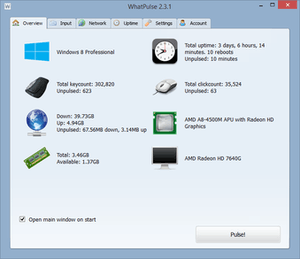WhatPulse
WhatPulse is a key-counting program that monitors computer uptime, bandwidth usage and the number of keystrokes and mouse clicks made by a user over a period of time. Unlike keyloggers, the authors claim WhatPulse does not record the order in which keys are pressed but instead counts the number of times keys are pressed.[2] As of January 3, 2020, over 328,000+ users are active on WhatPulse.[3]
 Screenshot from WhatPulse 2.3.1 | |
| Developer(s) | Martijn Smit |
|---|---|
| Initial release | 9 February 2003 |
| Stable release | 2.8.4[1]
/ 16 November 2018 |
| Written in | C++ |
| Operating system | Microsoft Windows macOS |
| Platform | Qt |
| Type | Usage statistics (Key & mouse click counting, bandwidth and uptime measuring) |
| License | Freeware |
| Website | whatpulse |
Features
The software tracks a user's pressed keys, mouse clicks and used bandwidth and the uptime of the system. Periodically, the user can upload to the server the number of keystrokes made; this is called "pulsing". Users can see where they are in a leaderboard of people who have joined the program and compare themselves against people from their own countries. Users can also join teams, which enables them to compare themselves against people with similar interests.
The latest versions of WhatPulse included anti-cheat measures. Automated measures against cheating include a 50 keys per second maximum.[4]
Platform compatibility
WhatPulse is a freeware cross-platform application, running on Windows, macOS, and Linux.[5] However, the Mac and Linux clients were not always updated as often as the Windows client. This changed in the latest version, 2.0, which became available for all platforms at the same time and aims at letting the client act the same across all platforms.
Version history
Major versions and notable features for the Windows client are listed below:[6][7]
| Version number | Changes |
|---|---|
| 1.0 (6 February 2003) | Initial release. Pressed keys were counted. |
| 1.1 (12 November 2003) | The following features were added:
|
| 1.2 (1 January 2004) | Clicks are now counted along with pressed keys. |
| 1.3 (15 May 2004) | The client now counts and stores which keys have been pressed, and how many times. (The order of the keys are not stored, not making the program a keylogger) |
| 1.4 (10 September 2004) |
|
| 1.5 (19 August 2006) |
|
| 1.6 (12 March 2009) |
|
| 1.7 (10 August 2010) |
|
| 2.0 (22 December 2012) |
|
| 2.0.1 (31 December 2012) |
|
| 2.0.4 (1 February 2013) |
Fixed in Linux
Fixed in Windows
Enhancements in Mac OS X
|
| 2.1 (26 April 2013) |
Fixes:
Improvements:
|
| 2.2 (8 September 2013) |
|
| 2.2.1 (15 September 2013) |
|
| 2.3 (27 November 2013) |
New:
Fixed:
Improved:
|
| 2.3.1 (12 December 2013) |
New:
Improved:
Fixed:
|
| 2.4 (19 April 2014) |
New:
Improved:
Fixed:
|
| 2.4.1 (28 September 2014) |
New:
Improved:
Fixed:
|
| 2.5 (9 December 2014)[8] |
New:
Improved:
Fixed:
|
References
- http://whatpulse.org/releasenotes/2.8.4/
- "Does WhatPulse contain any spyware?". WhatPulse.
- "Signup Statistics". WhatPulse. Retrieved 3 January 2020.
- "What does "Activity Breached" mean?". WhatPulse Wiki. Archived from the original on 12 November 2016. Retrieved 25 July 2013.
- "Downloads". WhatPulse.
- "News posts". WhatPulse. Archived from the original on 30 November 2010. Retrieved 25 July 2013.
- Smit, Martijn (22 December 2012). "WhatPulse 2.0!". WhatPulse. Retrieved 25 July 2013.
- "WhatPulse 2.5". WhatPulse.